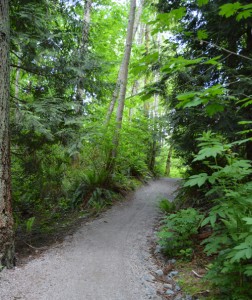 We focused on bryophytes (mosses and liverworts) during our walk. From the trail out of the west side of the bog we turned left and went down the first trail. We looked at a number of mosses and liverworts that provided an overview of some of the really interesting features of this fascinating group of organisms. We noticed the different forms as well as the variety of substrates on which bryophytes grow.
We focused on bryophytes (mosses and liverworts) during our walk. From the trail out of the west side of the bog we turned left and went down the first trail. We looked at a number of mosses and liverworts that provided an overview of some of the really interesting features of this fascinating group of organisms. We noticed the different forms as well as the variety of substrates on which bryophytes grow.
Hylocomium splendens
 Mosses are the second largest group of plants in terms of species numbers. Even though they are small and have similar features there is lots of interesting variation. Mosses are often categorized based on growth form. This moss is a feather moss because it looks like a feather. Its common name is step moss because every year it makes a new branch from the middle of an old one so it looks like a steps.
Mosses are the second largest group of plants in terms of species numbers. Even though they are small and have similar features there is lots of interesting variation. Mosses are often categorized based on growth form. This moss is a feather moss because it looks like a feather. Its common name is step moss because every year it makes a new branch from the middle of an old one so it looks like a steps.
Plagiomnium insigne
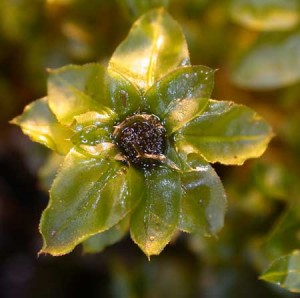 Badge moss (named because it looks like a badge or insignia) has very large, pointy, spirally arranged leaves. This is a cushion moss as the shoots are upright. Leaves of mosses have blades that are one cell thick. Some mosses, such as this one, have a midrib which is many layered. The plants we found were male. The middle part produces sperm within a ring of leaves which help to splash the sperm hopefully close to a female plant. Most mosses are dioicous (male and female reproductive structures on different individuals).
Badge moss (named because it looks like a badge or insignia) has very large, pointy, spirally arranged leaves. This is a cushion moss as the shoots are upright. Leaves of mosses have blades that are one cell thick. Some mosses, such as this one, have a midrib which is many layered. The plants we found were male. The middle part produces sperm within a ring of leaves which help to splash the sperm hopefully close to a female plant. Most mosses are dioicous (male and female reproductive structures on different individuals).
 We didn’t get to see female plants of Plagiomnium on our walk, but here is a picture to show you the sporophyte generation which develops from a fertilized egg which would therefore be from a female gametophyte. The sporophyte is dependent on the gametophyte for water and nutrients. It is made up of a foot (attachment to the gametophyte), a stalk (seta), and a sporangium (capsule that produces spores). In mosses the seta elongates prior to the development of the sporangium. There are most often only one sporophyte produced per gametophyte. Plagiomnium insigne, however can produce several. In fact in my bryology class we counted 10 sporophytes from one sample during a field trip!
We didn’t get to see female plants of Plagiomnium on our walk, but here is a picture to show you the sporophyte generation which develops from a fertilized egg which would therefore be from a female gametophyte. The sporophyte is dependent on the gametophyte for water and nutrients. It is made up of a foot (attachment to the gametophyte), a stalk (seta), and a sporangium (capsule that produces spores). In mosses the seta elongates prior to the development of the sporangium. There are most often only one sporophyte produced per gametophyte. Plagiomnium insigne, however can produce several. In fact in my bryology class we counted 10 sporophytes from one sample during a field trip!
Porella navicularis
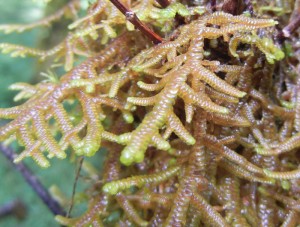 Commonly called scale moss, this is no moss at all! It is a leafy liverwort. Note that the leaves are arranged in two main lateral rows characteristic of this group of bryophytes. This gives liverworts a flattened appearance. Many leafy liverworts, including this one, has a third row of leaves along its underside. Porella is epiphytic, most often seen growing on deciduous trees.
Commonly called scale moss, this is no moss at all! It is a leafy liverwort. Note that the leaves are arranged in two main lateral rows characteristic of this group of bryophytes. This gives liverworts a flattened appearance. Many leafy liverworts, including this one, has a third row of leaves along its underside. Porella is epiphytic, most often seen growing on deciduous trees.
 The sporophytes of mosses and liverworts are similar. In liverworts the stalk bearing the sporangium elongates after the sporangium has matured. The sporangium splits open along four lines and the spores are dispersed quickly. The seta is not wiry like in mosses and collapses soon after spore release. This is an excellent time of year to go on a sporophyte hunt for Porella.
The sporophytes of mosses and liverworts are similar. In liverworts the stalk bearing the sporangium elongates after the sporangium has matured. The sporangium splits open along four lines and the spores are dispersed quickly. The seta is not wiry like in mosses and collapses soon after spore release. This is an excellent time of year to go on a sporophyte hunt for Porella.
Marchantia polymorpha
 Thalloid liverworts do not have differentiated stem and leaves. They lie flat along the ground and have a ribbon-like structure. In this picture you can see the elevated sporophyte producing structures. The sporophytes hang down releasing spores into the air currents. This is one of the few mosses that is considered a pest. It is a common weed in greenhouses and gardens. This specimen was not observed on the walk, but a specimen was provided to contrast leafy and thalloid liverworts.
Thalloid liverworts do not have differentiated stem and leaves. They lie flat along the ground and have a ribbon-like structure. In this picture you can see the elevated sporophyte producing structures. The sporophytes hang down releasing spores into the air currents. This is one of the few mosses that is considered a pest. It is a common weed in greenhouses and gardens. This specimen was not observed on the walk, but a specimen was provided to contrast leafy and thalloid liverworts.
Rhizomnium glabrescens
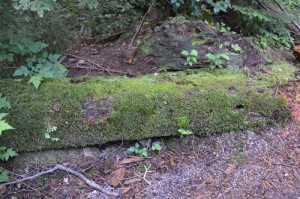 This log is covered primarily with Rhizomnium glabrescens. In mosses when a spore germinates it produces a filamentous mass, called protonema, that grows over the substrate. Many shoots arise for these filaments so from one spore many shoots are produced….it makes it almost impossible to distinguish the products of one spore from another. This log could be colonized by only a few spores!
This log is covered primarily with Rhizomnium glabrescens. In mosses when a spore germinates it produces a filamentous mass, called protonema, that grows over the substrate. Many shoots arise for these filaments so from one spore many shoots are produced….it makes it almost impossible to distinguish the products of one spore from another. This log could be colonized by only a few spores!
 Here is a patch that is being newly colonized by Rhizomnium. You can see the browny felt that is a combination of protonema and rhizoids. Rhizoids are small hairs that attach bryophytes to substrates. You can also see young shoots arising from the felting brown felt. Rhizomnium grows on a number of substrates in the shady forest. You will find it on living trees as well as sometimes on rocks and forest floor.
Here is a patch that is being newly colonized by Rhizomnium. You can see the browny felt that is a combination of protonema and rhizoids. Rhizoids are small hairs that attach bryophytes to substrates. You can also see young shoots arising from the felting brown felt. Rhizomnium grows on a number of substrates in the shady forest. You will find it on living trees as well as sometimes on rocks and forest floor.
 The male plants of Rhizomnium glabrescens are similar to Plagiomnium insigne, but notice that the leaves are rounded. Upon closer inspection (i.e. with a hand lens) you will see that there are no teeth along the margin of the leaves (there are in P. insigne). Like Plagiomnium insigne the male and female plants are separate and a splashcup mechanism is important for sperm dispersal.
The male plants of Rhizomnium glabrescens are similar to Plagiomnium insigne, but notice that the leaves are rounded. Upon closer inspection (i.e. with a hand lens) you will see that there are no teeth along the margin of the leaves (there are in P. insigne). Like Plagiomnium insigne the male and female plants are separate and a splashcup mechanism is important for sperm dispersal.
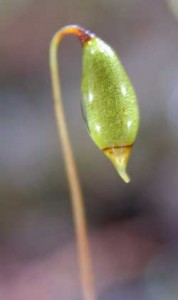 Here is a close up of a sporangium. There is a little cap, called an operculum, that will fall off when the spores are ready to be released. The spores of most mosses are dispersed over a long period of time. They can be carried a fair distance in the wind as they are light.
Here is a close up of a sporangium. There is a little cap, called an operculum, that will fall off when the spores are ready to be released. The spores of most mosses are dispersed over a long period of time. They can be carried a fair distance in the wind as they are light.
 To the right is an old sporangium which has lost its operculum and already dispersed its spores. The sporangial hole is surrounded by structures called peristome teeth. Rhizomnium belongs to a group of mosses known as the joint-toothed mosses, so called because their teeth move at joints along the teeth to aid in spore dispersal in response to moisture. The joint-toothed mosses are the most speciose group of mosses.
To the right is an old sporangium which has lost its operculum and already dispersed its spores. The sporangial hole is surrounded by structures called peristome teeth. Rhizomnium belongs to a group of mosses known as the joint-toothed mosses, so called because their teeth move at joints along the teeth to aid in spore dispersal in response to moisture. The joint-toothed mosses are the most speciose group of mosses.
Dicranum scoparium
 This moss’ common name is broom moss (or witches’ broom moss) because the leaves are curved and pointing in one direction like an old fashion broom.
This moss’ common name is broom moss (or witches’ broom moss) because the leaves are curved and pointing in one direction like an old fashion broom.  You will find this moss in a number of different habitats and on a number of substrates. It grows in the shady forest (on soil, epiphytic both low and higher up in the canopy), but you will also find it in sunny spots like in the bog. It is in Camosun Bog….the leaves are less curved that those on the specimens in the woods.
You will find this moss in a number of different habitats and on a number of substrates. It grows in the shady forest (on soil, epiphytic both low and higher up in the canopy), but you will also find it in sunny spots like in the bog. It is in Camosun Bog….the leaves are less curved that those on the specimens in the woods.
Isothecium stoloniferum
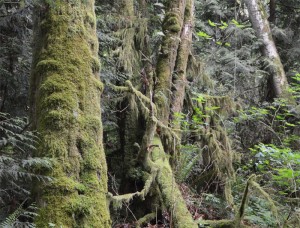 This is common moss found in our forests. You can see it here on the trees to the right hanging like hair from the trees. the trunk on the left also has some….growing alongside Claopodium crispifolium, Dicranum scoparium, and Eurynchium oreganum (=Kindbergia oregana). Click on on the picture to see it in higher magnification. You can also see licorice fern growing on the big leaf maple in the back. Moss generates the substrate for the fern to grow!
This is common moss found in our forests. You can see it here on the trees to the right hanging like hair from the trees. the trunk on the left also has some….growing alongside Claopodium crispifolium, Dicranum scoparium, and Eurynchium oreganum (=Kindbergia oregana). Click on on the picture to see it in higher magnification. You can also see licorice fern growing on the big leaf maple in the back. Moss generates the substrate for the fern to grow!
Buckiella undulata (formerly known as Plagiothecium undulatum)
 This is a moss that likes to look like a liverwort….it has a flattened appearance.
This is a moss that likes to look like a liverwort….it has a flattened appearance.  The leaves, howeer, are still spirally arranged…it is just like someone came along and ironed it. It is a moss with a number of common names: wavy-leaved cotton moss, tongue moss, snake moss…
The leaves, howeer, are still spirally arranged…it is just like someone came along and ironed it. It is a moss with a number of common names: wavy-leaved cotton moss, tongue moss, snake moss…
Tetraphis pellucida
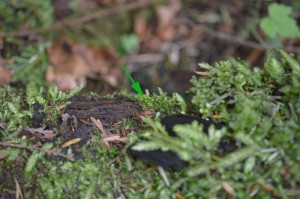 While Buckiella undulata is the most obvious bryophyte on this decomposing log there are a number of other bryos. Take a close look at this cluster of very small shoots. This is a very interesting moss called Tetraphis pellucida (indicates with the arrow). The genus name refers to the fact that the sporangium has four peristome teeth.
While Buckiella undulata is the most obvious bryophyte on this decomposing log there are a number of other bryos. Take a close look at this cluster of very small shoots. This is a very interesting moss called Tetraphis pellucida (indicates with the arrow). The genus name refers to the fact that the sporangium has four peristome teeth.
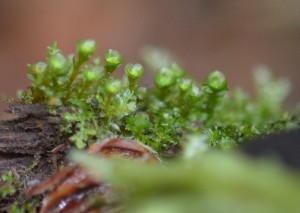 The shoots we see here are producing gemma (asexual propagules) from within a rosette of leaves. The gemmae are dispersed via a splash cup mechanism. While there is adequate substrate these shoots will proliferate and continue to colonize. However, when they start to become crowded (or encroached upon by other species) they will start to produce gamete-bearing shoots and turn to sexual reproduction. This will result in spore production which are a longer distance dispersal unit. They will be released and hopefully find an uninhabited bit of rotting wood….in a shady spot.
The shoots we see here are producing gemma (asexual propagules) from within a rosette of leaves. The gemmae are dispersed via a splash cup mechanism. While there is adequate substrate these shoots will proliferate and continue to colonize. However, when they start to become crowded (or encroached upon by other species) they will start to produce gamete-bearing shoots and turn to sexual reproduction. This will result in spore production which are a longer distance dispersal unit. They will be released and hopefully find an uninhabited bit of rotting wood….in a shady spot.
Lepidozia reptans
 Most of the fuzz you see on decomposing wood in the woods is a little liverwort
Most of the fuzz you see on decomposing wood in the woods is a little liverwort  lovingly called Micky Mouse hands liverworts (even D. Wilf Schofield liked this common name).
lovingly called Micky Mouse hands liverworts (even D. Wilf Schofield liked this common name).
Lepidozia reptans has lobed leaves that look like little hands. They are so small it is challenging to examine them even with a hand lens.
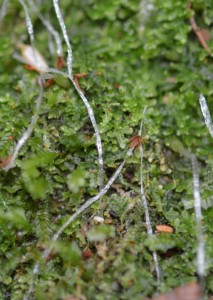 In this (not very good) picture you can see the sporophyte stalks (seta) which have collapsed as the spores have been released. If you look closely you can see that the sporangium has split open giving it a flower-like appearance. Liverworts have cells called elaters that are intermixed with the spores that wriggle around in response to changes in humidity. They break up the spore mass facilitating spore dispersal, You may have thought to yourself….the leafy and thalloid liverworts look so different; why are they classified together in the same group. While their gametophytes look so different there are many commonalities in the sporophyte generation, including the presence of elaters, that indicate their close relationship. This has been confirmed with DNA research.
In this (not very good) picture you can see the sporophyte stalks (seta) which have collapsed as the spores have been released. If you look closely you can see that the sporangium has split open giving it a flower-like appearance. Liverworts have cells called elaters that are intermixed with the spores that wriggle around in response to changes in humidity. They break up the spore mass facilitating spore dispersal, You may have thought to yourself….the leafy and thalloid liverworts look so different; why are they classified together in the same group. While their gametophytes look so different there are many commonalities in the sporophyte generation, including the presence of elaters, that indicate their close relationship. This has been confirmed with DNA research.
 Here is a Lepidozia laden stump. You can see the springboard notches from logging done in the early 1900’s. These are where planks were attached to support the loggers as they cut down the tree (with hand saws). You can also see singe marks on many of these old stumps as burning was part of the logging practice of that era. We are standing in part of the forest that would have been adjacent to Camosun Bog.
Here is a Lepidozia laden stump. You can see the springboard notches from logging done in the early 1900’s. These are where planks were attached to support the loggers as they cut down the tree (with hand saws). You can also see singe marks on many of these old stumps as burning was part of the logging practice of that era. We are standing in part of the forest that would have been adjacent to Camosun Bog.
